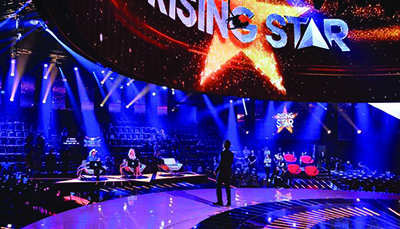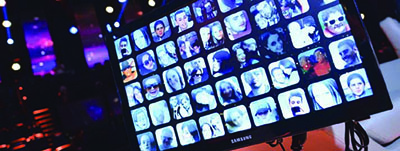ABC's ‘Rising Star’ Is Born Through Social Media
LOS ANGELES—Many singers hope to belt out a tune and raise the roof, but this summer the singers on ABC’s summer reality program “Rising Star” were hoping to raise the wall instead. Unlike other singing competitions on TV that feature a cast of celebrity judges, the singers on “Rising Star” were judged by the viewers at home with hopes of winning the title “The Next Rising Star” and a recording contract with Capitol Records.
During each performance, tight social media integration allowed the viewing audience at home to become the judges by deciding in real time via a mobile smartphone app whether or not the contestant would advance to the next round.

Each performance on ABC’s “Rising Star” began with the contestant singing behind a large screen known simply as “the Wall.” As with other singing shows, “Rising Star” (which ran from June 22 to Aug. 24), features celebrity “expert” panelists, including host Josh Groban and singers Brad Paisley, Kesha and Ludacris, who did influence the vote, but it was truly the audience at home that determined whether a singer should stay or go. In that way, “Rising Star,” which is based on the Israeli signing competition “HaKokhav HaBa (The Next Star),” offered greater social media engagement than just having viewers tweet about the contestants.
“Absolutely,” says Emmy Award- and Producers Guild Award-winning producer Nicolle Yaron, the show’s executive producer. “I’ve been interested in incorporating social media into TV since the early days of Twitter and Facebook. I’ve always been interested in integrating this technology into the TV viewing experience as it allows that closer connection between the audience and the experience.”
A ‘PSYCHOLOGICAL CHANGE’
Where “Rising Star” also played out differently was that each performance began with the contestant singing behind a large screen, known simply as “The Wall.” Once the singer reached 70 percent “yes” votes, the wall rose, allowing the contestant to advance to the next round.
The show used social media in a way that other singing competitions and reality shows have been unable to. While reality shows long ago broke the fourth wall in talking to the audience, “Rising Star” successfully took social media beyond the second screen of smartphones and tablets and made it part of the show itself.
“There is no show without the second screen,” says Yaron, “but ‘Rising Star’ is taking this from a second-screen to a main-screen experience. This is truly a show where the experience on your mobile device fuels the broadcast experience. There is simply no other way to vote and participate. Without the smartphone, it would just be a live concert on TV.”
The professional video industry's #1 source for news, trends and product and tech information. Sign up below.

On-stage judges were able to see the voting public icons on screens beside their chair. “Nothing has given power to the people the way this show has,” says Ariel Elazar, vice president of digital distribution and brand licensing at Dick Clark Productions (DCP). “Audience members have the power to vote for a contestant, maybe see their face displayed on the wall, then raise the wall and share their opinion with the rest of the audience about the contestant and really feel like a judge. That has to be invigorating for the viewer.”
This has resulted in a psychological change, according to Eli Uzan of Screenz Cross Media, which provides the technology that enables viewers to connect with the show through social media. “With ‘Rising Star,’ there is a full experience of being a judge,” Uzan says. “It is the same experience as the judges in the studio, and this gives a different experience than just being a fan of the contestant.”
By so immersing the audience in the voting experience, “Rising Star” in the process became a Sunday night summer destination, as viewers had to be there to be part of the full experience.
“This gives a lot of power to the audience. Everything is happening in real time and happening live. We all get the results at the same time,” says Shahar Shpalter, a digital show runner at Keshet DCP, which produces the show. “It is a game changer because TV producers like to control the show, but here the digital element is so transparent that it is part of the show. The technology has to work or else we don’t have a show.”
SUMMER SENSATION
For ABC, this created a buzzworthy experience during the summer season, once considered a time to air reruns and burn off shows that failed to connect with audiences during the regular season. The use of social media and smartphones enabled “Rising Star” to connect with an audience that is more likely to be hitting the beach or pool during the summer instead of staying glued to the set.
“We dominated the younger demographics in the ratings,” Yaron says. “There is all this talk that younger people today don’t have TV, but I believe these moments where people are gathering around the TV are like the way our ancestors gathered around the fire to share stories. It is shows like this that connect us, too. We’re often living so far apart that the TV is a way to stay connected today, creating that collective experience.”
Viewers were able to become “Rising Star” judges by downloading an app for Apple’s iOS, Google’s Android or Microsoft’s Windows Phone operating systems. “Through smartphones we are able to support more than 90 percent of the market,” says Uzan. “Screenz is looking to integrate other technology so that everyone can be a part of this.”
Voting through a computer or web browser is not a barrier from a technology perspective, Shpalter adds, but he emphasizes that the goal was to maintain the traditional viewing experience with second screen devices, namely the smartphone.
“This is related to the format and the way we wanted the user to experience the show,” says Shpalter. “We see a difference in how people watch TV when they have a laptop on their knees versus holding a smartphone. This is something that is important because we don’t want to change the way viewers watch TV. This is how they are already doing it. That is basically a decision rather than a technology challenge.”
Because the show involved viewer voting, it meant that each week the first stop included pulling the information from each verified home judge, and a filtering system made sure that nothing that shouldn’t appear mades its way to the wall. Supplementary content included avatars and pictures from viewers.
The show’s Interactive Studio System put the pictures on the wall, visualized the voting bar and the score, and presented it in just a few seconds. “It is one big platform and everything is made by Screenz,” Uzan adds. “The end users see the app, but there is a huge platform behind it. The big challenge is to deal with millions of concurrent users at the same time. The main challenge is not on the client side—90 percent is on the back end, on the server side of the platform. This is a bigger challenge, much more than the end users.”
The wall may look good on TV, but, as Yaron admits, it wasn’t exactly easy for the audio engineers or camera to deal with it at times, especially in a live performance.
“There have been hurdles along the way,” she says, “but we had the absolute best in the field to help us deal with these challenges that we’ve never had to deal with before. But again, this could change TV. This is a way to get young people to watch live TV and become more than the audience.”
It could also redefine what viewers expect to see in reality programming, notes DCP’s Elazar, who explains that reality shows have progressed from putting the next-door neighbor on TV and making them a star. Now, a decade after the advent of social media, it is helping to make the viewers an integral part of the show as well.
“This is about the cultural challenges, and social media is a part of it,” says Elazar. “This is the way that the viewer or user can produce or create the content. It’s the opportunity that social media and technology give us. We will see it in more and more TV shows and more and more screens going forward, of course. Future TV shows will live on more than just the main TV screen.”
